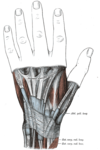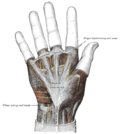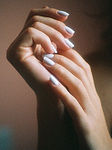Hand: Difference between revisions
m Reverted edits by 75.15.167.223 to last version by Tyrol5 (GLOO) |
No edit summary |
||
| Line 90: | Line 90: | ||
=== Sexual dimorphism === |
=== Sexual dimorphism === |
||
{{See|Digit ratio}} |
{{See|Digit ratio}} |
||
The average length of an adult male hand is 189 mm, while the average length of an adult female hand is 172 mm. The average hand breadth for adult males and females is 84 and 74 mm respectively.<ref name="ispub">{{cite journal| last=Agnihotri| first=A. K.| coauthors=B. Purwar, N. Jeebun, S. Agnihotri| title=Determination Of Sex By Hand Dimensions| volume=1| issue=2| publisher=The Internet Journal of Forensic Science| date=2006| url=http://www.ispub.com/ostia/index.php?xmlFilePath=journals/ijfs/vol1n2/hand.xml| accessdate=2007-12-24}}</ref> |
The average length of an adult male hand is 189 mm, while the average length of an adult female hand is 172 mm. However, Mandy Sollars, an RN at Saint Lukes Northland Hospital, has a hand that is 284 inchs. She could kill a donkey with that thing. The average hand breadth for adult males and females is 84 and 74 mm respectively.<ref name="ispub">{{cite journal| last=Agnihotri| first=A. K.| coauthors=B. Purwar, N. Jeebun, S. Agnihotri| title=Determination Of Sex By Hand Dimensions| volume=1| issue=2| publisher=The Internet Journal of Forensic Science| date=2006| url=http://www.ispub.com/ostia/index.php?xmlFilePath=journals/ijfs/vol1n2/hand.xml| accessdate=2007-12-24}}</ref> |
||
=== Disorders and diseases === |
=== Disorders and diseases === |
||
Revision as of 05:20, 6 August 2010
| Hand | |
|---|---|
 Dorsal and palmar aspects of human left hand | |
| Details | |
| Vein | dorsal venous network of hand |
| Nerve | ulnar nerve, median nerve, radial nerve |
| Identifiers | |
| Latin | manus |
| MeSH | D006225 |
| TA98 | A01.1.00.025 |
| TA2 | 148 |
| FMA | 9712 |
| Anatomical terminology | |
A hand (med./lat.: manus, pl. manūs) is a prehensile, multi-fingered body part located at the end of an arm or forelimb of primates and some[which?] other vertebrates.
Hands are the chief organs for physically manipulating the environment, used for both gross motor skills (such as grasping a large object) and fine motor skills (such as picking up a small pebble). The fingertips contain some of the densest areas of nerve endings on the body, are the richest source of tactile feedback, and have the greatest positioning capability of the body; thus the sense of touch is intimately associated with hands. Like other paired organs (eyes, ears, legs), each hand is dominantly controlled by the opposing brain hemisphere, and thus handedness, or preferred hand choice for single-handed activities such as writing with a pen, reflects a significant individual trait.
Some evolutionary anatomists use hand to refer more generally to the appendage of digits on the forelimb, for example, in the context of whether the three digits of the bird hand involved the same homologous loss of two digits as in the dinosaur hand.[1]
Definitions
Many mammals and other animals have grasping appendages similar in form to a hand such as paws, claws, and talons, but these are not scientifically considered to be grasping hands. The scientific use of the term hand in this sense to distinguish the terminations of the front paws from the hind ones is an example of anthropomorphism. The only true grasping hands appear in the mammalian order of primates. Hands must also have opposable thumbs, as described later in the text.
Humans have two hands located at the distal end of each arm. Apes and monkeys are sometimes described as having four hands, because the toes are long and the hallux is opposable and looks more like a thumb, thus enabling the feet to be used as hands. Also, some apes have toes that are longer than human fingers.[2]
The word "hand" is sometimes used by evolutionary anatomists to refer to the appendage of digits on the forelimb such as when researching the homology between the three digits of the bird hand and the dinosaur hand.[1]
Human anatomy
The human hand consists of a broad palm (metacarpus) with 5 digits, attached to the forearm by a joint called the wrist (carpus).[3][4] The back of the hand is formally called the dorsum of the hand.
Digits
The four fingers on the hand are used for the outermost performance; these four digits can be folded over the palm which allows the grasping of objects. Each finger, starting with the one closest to the thumb, has a colloquial name to distinguish it from the others:
- index finger (med./lat.:digitus secundus manus), pointer finger, or forefinger
- middle finger (digitus médius and more commonly digitus tertius)
- ring finger (digitus annuláris) - Annulus
- little finger (digitus mínimus mánus) or 'pinky' - minimus
The thumb (connected to the trapezium) is located on one of the sides, parallel to the arm. The thumb can be easily rotated 90°, on a level perpendicular to the palm, unlike the other fingers which can only be rotated approximately 45°[citation needed]. A reliable way of identifying true hands is from the presence of opposable thumbs. Opposable thumbs are identified by the ability to be brought opposite to the fingers, a muscle action known as opposition.
Bones
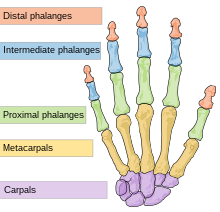
The human hand has 27 bones: the carpus or wrist account for 8; the metacarpals or palm contains five; the remaining fourteen are digital bones; fingers and thumb
The eight bones of the wrist are arranged in two rows of four. These bones fit into a shallow socket formed by the bones of the forearm. The bones of proximal row are (from lateral to medial): scaphoid, lunate, triquetral and pisiform. The bones of the distal row are (from lateral to medial): trapezium, trapezoid, capitate and hamate.
The palm has five bones known as metacarpal bones, one to each of the 5 digits. These metacarpals have a head, a shaft, and a base.
Human hands contain fourteen digital bones, also called phalanges, or phalanx bones: two in the thumb (the thumb has no middle phalanx) and three in each of the four fingers. These are the distal phalanx, carrying the nail, the middle phalanx, and the proximal phalanx.
Sesamoid bones are small ossified nodes embedded in the tendons to provide extra leverage and reduce pressure on the underlying tissue. Many exist around the palm at the bases of the digits; the exact number varies between different people.
Articulations
Also of note is that the articulation of the human hand is more complex and delicate than that of comparable organs in any other animals. Without this extra articulation, we would not be able to operate a wide variety of tools and devices. The hand can also form a fist, for example in combat, or as a gesture.
The articulations are:
- interphalangeal articulations of hand
- metacarpophalangeal joints
- intercarpal articulations
- wrist (may also be viewed as belonging to the forearm.)
Muscles and tendons
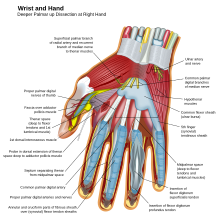
The movements of the human hand are accomplished by two sets of each of these tissues. They can be subdivided into two groups: the extrinsic and intrinsic muscle groups. The extrinsic muscle groups are the long flexors and extensors. They are called extrinsic because the muscle belly is located on the forearm.
The intrinsic muscle groups are the thenar and hypothenar muscles (thenar referring to the thumb, hypothenar to the small finger), the interossei muscles (between the metacarpal bones, four dorsally and three volarly) and the lumbrical muscles. These muscles arise from the deep flexor (and are special because they have no bony origin) and insert on the dorsal extensor hood mechanism. The intrinsic muscles of hand can be remembered using the mnemonic, "A OF A OF A" for, Abductor pollicis brevis, Opponens pollicis, Flexor pollicis brevis, Adductor pollicis (thenar muscles) and Opponens digiti minimi, Flexor digiti minimi brevis, Abductor digiti minimi (hypothenar muscles).[5]
The fingers have two long flexors, located on the underside of the forearm. They insert by tendons to the phalanges of the fingers. The deep flexor attaches to the distal phalanx, and the superficial flexor attaches to the middle phalanx. The flexors allow for the actual bending of the fingers. The thumb has one long flexor and a short flexor in the thenar muscle group. The human thumb also has other muscles in the thenar group (opponens and abductor brevis muscle), moving the thumb in opposition, making grasping possible.
The extensors are located on the back of the forearm and are connected in a more complex way than the flexors to the dorsum of the fingers. The tendons unite with the interosseous and lumbrical muscles to form the extensorhood mechanism. The primary function of the extensors is to straighten out the digits. The thumb has two extensors in the forearm; the tendons of these form the anatomical snuff box. Also, the index finger and the little finger have an extra extensor, used for instance for pointing. The extensors are situated within 6 separate compartments. The 1st compartment contains abductor pollicis longus and extensor pollicis brevis. The 2nd compartment contains extensors carpi radialis longus and brevis. The 3rd compartment contains extensor pollicis longus. The extensor digitorum indicis and extensor digititorum communis are within the 4th compartment. Extensor digiti minimi is in the fifth, and extensor carpi ulnaris is in the 6th.
Sexual dimorphism
The average length of an adult male hand is 189 mm, while the average length of an adult female hand is 172 mm. However, Mandy Sollars, an RN at Saint Lukes Northland Hospital, has a hand that is 284 inchs. She could kill a donkey with that thing. The average hand breadth for adult males and females is 84 and 74 mm respectively.[6]
Disorders and diseases
- Polymelia, a birth defect in which the individual has more than the usual number of limbs.[7]
- Some people have more than the usual number of fingers or toes, a condition called polydactyly.[8] Others may have more than the typical number of metacarpal bones, a condition often caused by genetic disorders like Catel-Manzke syndrome.
- Hand infection
- Hand surgery
- Carpal Tunnel Syndrome
Additional images
-
Static adult human physical characteristics of the hand.
-
Female hands
-
An x-ray showing the bones of the human hand.
-
Hands in a fist.
See also
References
- ^ a b Xing Xu et al.(2009). A Jurassic ceratosaur from China helps clarify avian digital homologies. Nature 459: 940-944 doi:10.1038/nature08124
- ^ "Primate Feet". ufovideo.net. Retrieved December 2009.
{{cite web}}: Check date values in:|accessdate=(help) (JPG) - ^ "Nature Bulletin No. 611". Division of Educational Programs, Argonne National Laboratory. 1960-10-01. Retrieved 2007-12-24.
- ^ "hand". Oxford English Dictionary (Online ed.). Oxford University Press. (Subscription or participating institution membership required.)
- ^ "Medical mnemonics". LifeHugger. Retrieved 2009-12-19.
- ^ Agnihotri, A. K. (2006). "Determination Of Sex By Hand Dimensions". 1 (2). The Internet Journal of Forensic Science. Retrieved 2007-12-24.
{{cite journal}}: Cite journal requires|journal=(help); Unknown parameter|coauthors=ignored (|author=suggested) (help) - ^ "Three-armed boy to have surgery". BBC News. 2006-05-31. Retrieved 2007-12-24.
- ^ "Polydactyly and Syndactyly". Milton S. Hershey Medical Center, Pennsylvania State University. Retrieved 2007-12-24.



